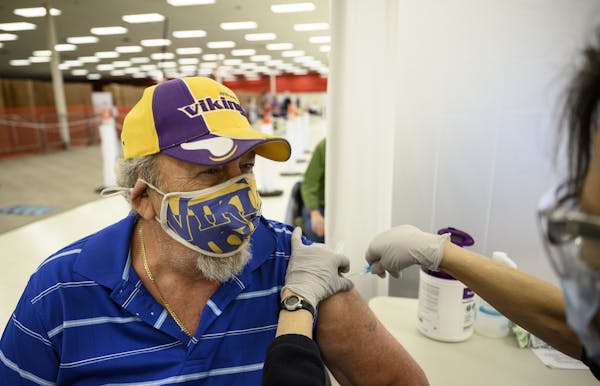There's stronger evidence that viral variants are driving COVID-19 case increases in Minnesota, health officials said Friday.
Given the trend, they stressed the need for caution with spring break plans and implementing new federal guidance over safe distancing in schools.
After plateauing in February, cases have begun to increase over the past two weeks with Friday marking a second consecutive day of about 1,500 newly reported infections.
At the same time, health officials suspect a more contagious form of the virus is driving the growth of infections in the southwest metro, the Mankato area and in St. Louis County, said Kris Ehresmann, the state's director for infectious disease, during a call with reporters on Friday.
"We are seeing concerning increases in a number of areas in Minnesota and suspect that the variant B.1.1.7 is driving the increase," Ehresmann said. The variant was identified last year in the United Kingdom.
The Centers for Disease Control and Prevention announced Friday that students wearing masks can safely sit 3 feet apart in the classroom, closer than the previous 6-foot standard that's been challenging for schools to implement.
Minnesota is reviewing the guidance but already requires that students maintain a distance of 3 feet in middle and high schools, which is consistent with the CDC's announcement, state Health Commissioner Jan Malcolm said. However, Minnesota recommends that schools maintain distances of 6 feet as much as possible, she said.
"As we continue to see variants spread and definite hot spots in Minnesota with case growth back on the rise, physical distancing along with consistent, universal masking is so important," Malcolm said. "We need to keep in mind we are seeing these variants spreading rapidly, particularly among sporting networks and schools."
The state Department of Health on Friday reported 1,449 new coronavirus cases and nine more deaths linked to COVID-19.
The seven-day rolling average for net case increases is now about 1,098 per day, according to the Star Tribune's coronavirus tracker. That's still down considerably from November, when the state averaged at one point more than 7,000 cases per day. Yet the comparable figure two weeks ago was about 742 cases per day, the lowest reading since September.
The state has used genomic sequencing to document more than 300 cases of the B.1.1.7 variant, up from more than 250 cases just a few days ago. Also on Friday, health officials said they have found 73 cases of two variants that were first found in California and were added this week to the CDC's list of variants of concern.
There also are signs that Minnesotans are becoming less compliant with health recommendations, Ehresmann said, citing data that suggests the share of state residents consistently wearing masks has slipped. Families will want to gather in the coming weeks for the Easter, Passover and Ramadan holidays, she noted, but the pandemic means that any gatherings "still need to look different."
Risk goes up when gathering with those outside your home, Ehresmann said, so people should check guidance on masks and keeping apart at both indoor and outdoor events. Health officials "strongly discourage" any unnecessary interstate or international travel, but say people who take a trip should quarantine upon return.
The latest pandemic numbers underscore the need for caution, Ehresmann said, because the increases resemble what Minnesota saw before the case surge last fall.
One big difference is the growing number of Minnesotans who have been vaccinated against COVID-19. The latest Health Department figures show a total of 2,082,088 vaccine doses administered.
The statewide tally for people who have received at least one vaccine dose increased by 34,682, according to data released Friday, for a total of 1,337,982 people so far. That's about 24% of the state's population, according to Star Tribune estimates.
The numbers are "great," Ehresmann said, "but we don't yet have enough Minnesotans vaccinated to have broad community-level protection. … We are in a race between the variants and the vaccine and the decisions we all make in the next few weeks will have a lot to say about the outcome of this race."
Statewide, recent case increases have come with small increases in COVID-19 patients requiring hospitalization. Yet the number of pandemic patients who require care is down significantly since late November, said Dr. Mark Sannes, an infectious disease specialist at HealthPartners. Across eight hospitals, the Bloomington-based health system has been seeing 20 to 30 patients at a time with COVID-19 in recent weeks, compared with about 230 at its peak.
"The folks that are hospitalized are less likely to land in the intensive care unit and less likely to land on the ventilator than at any time during the pandemic," Sannes said.
One factor seems to be that many Minnesotans at risk of the worst outcomes with COVID-19 have been getting vaccine. State data show that 77.5% of residents 65 and older have received at least one dose, Ehresmann said Friday, yet the share could be even higher. That's because the tally doesn't include doses administered by the Department of Veterans Affairs, she said, or Minnesota snowbirds who might have gotten shots while residing in out-of-state homes this winter.
The new variants are troubling because they are more contagious, and there's some evidence that some of them may be more virulent as well, said Dr. Marilyn Peitso, president of the Minnesota Medical Association.
"We are at a very critical juncture with the variants showing up in Minnesota, with good evidence that they really are behind some of the clusters that we are seeing," Peitso said. "It's definitely a time to be hopeful, but we cannot take our eyes off the ball."
Christopher Snowbeck • 612-673-4744
Carolyn Parnell, 'trailblazer' who served as Minnesota's first IT commissioner, dies


